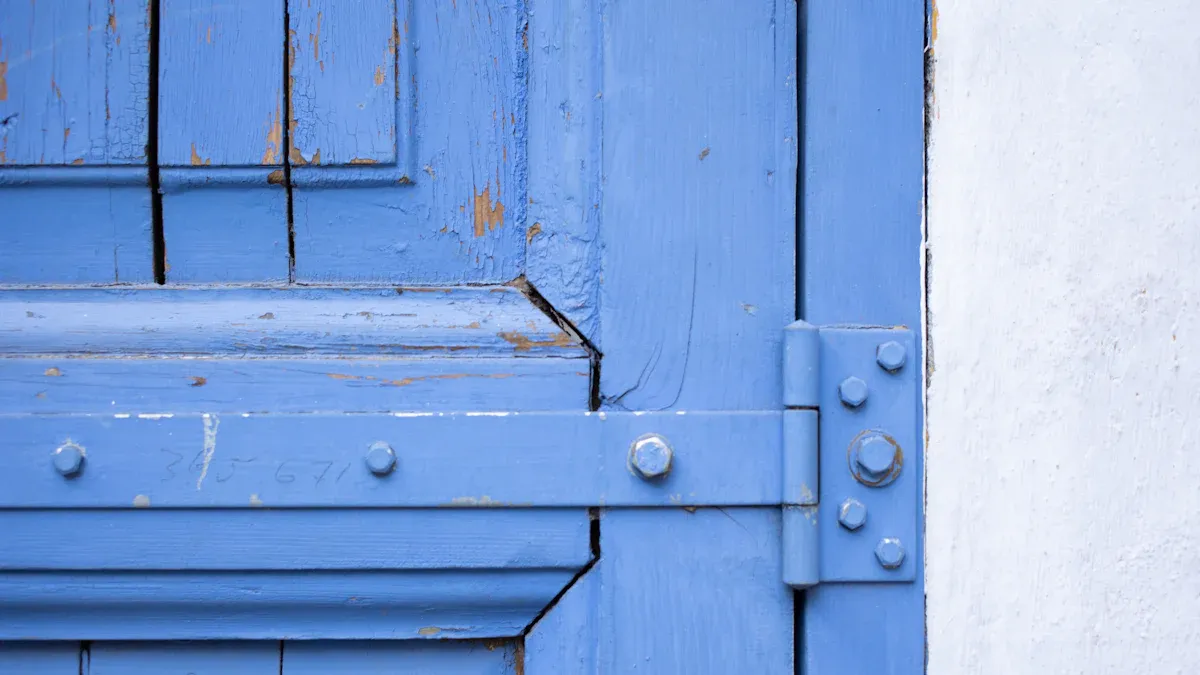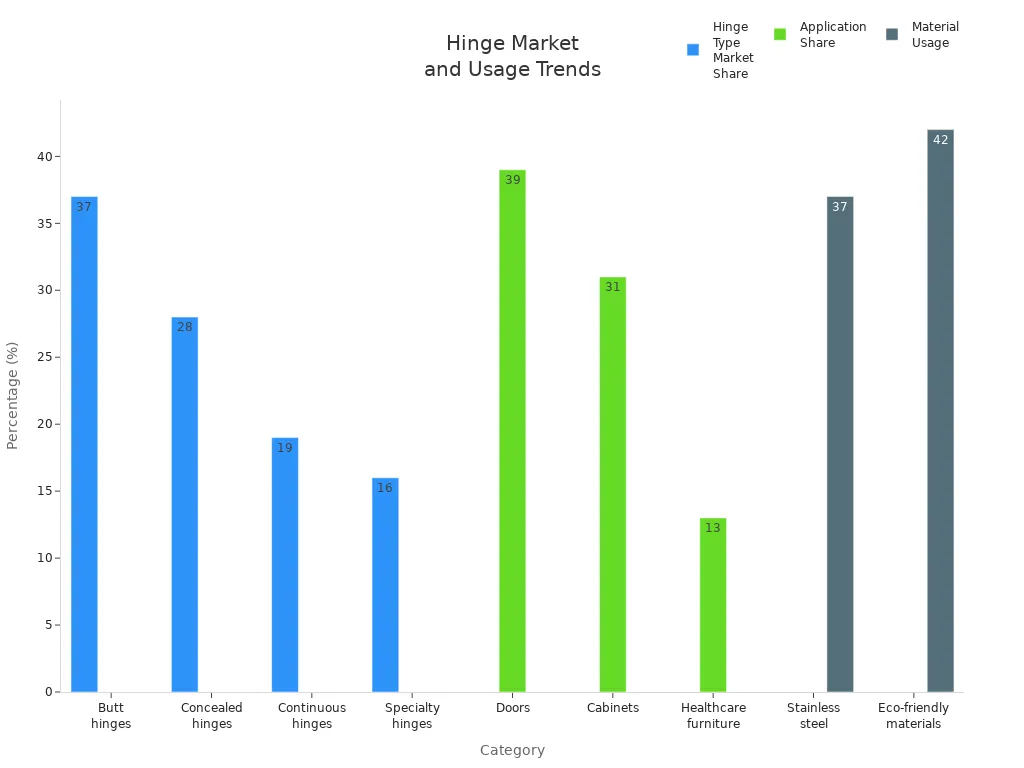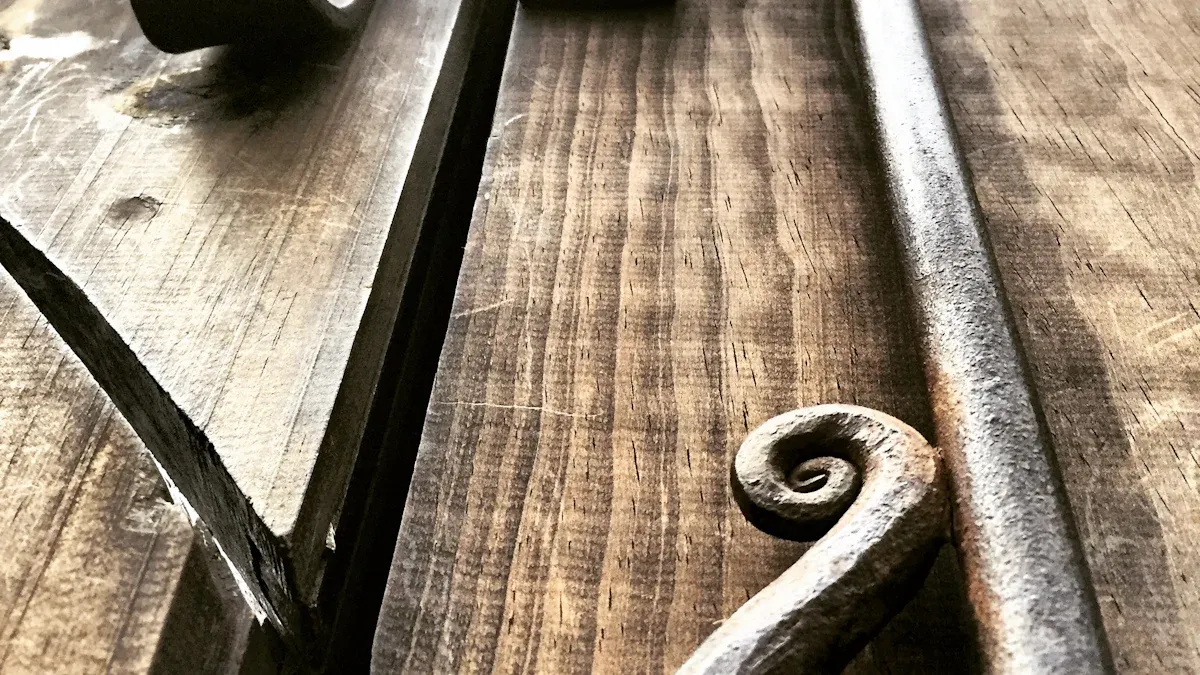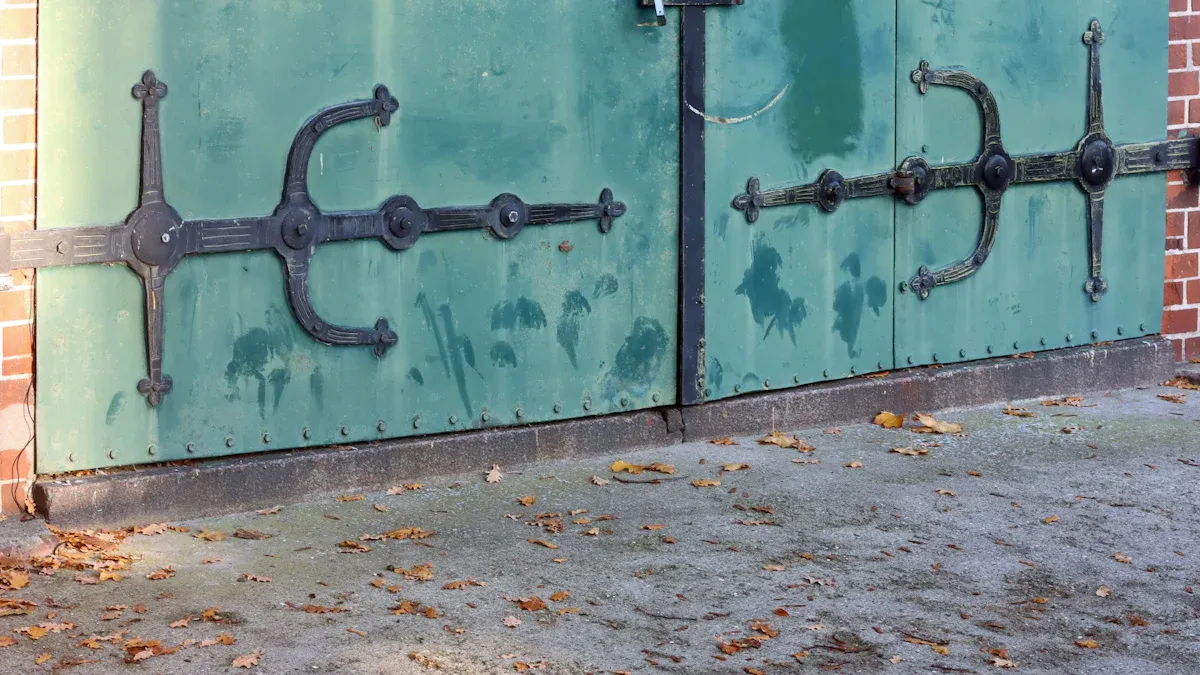How Tee Hinges Differ from Strap Hinges in 2025

Tee hinges have a T-shape that supports light to medium doors, while strap hinges use long arms for heavier gates or barn doors. You must choose the right hinge for durability and function.
| Aspect | Evidence Summary |
|---|---|
| Compatibility & Standardization | 32% of designers face compatibility challenges; 24% of manufacturers report increased customization time and costs due to lack of universal standards. |
| Material Choice | Stainless steel hinges favored in 37% of architectural projects for corrosion resistance and longevity. Eco-friendly materials constitute 42% of production, reflecting durability and sustainability concerns. |

Tee Hinges: Design and Structure

Appearance and Components
When you look at tee hinges, you notice their unique T-shape. This design helps support doors and gates by spreading weight across a wide area. Most tee hinges use steel for strength and durability. Manufacturers often add WeatherGuard™ protection, which helps the hinge resist rust and harsh weather. You can find offset holes on the hinge plates. These holes make the hinge stronger and help prevent the wood from splitting when you install it.
You have several material options for tee hinges. Stainless steel and galvanized steel work well in coastal or wet areas because they resist corrosion. Some hinges come with black or zinc-plated finishes for extra protection and a smooth look. Others use thermoplastic bushings to reduce friction and stop creaking. Choosing the right material ensures your hinge lasts longer and works smoothly.
Tip: Always match the hinge material to your local weather conditions for the best performance and longevity.
Typical Uses for Tee Hinges
Tee hinges fit many types of gates and doors. You often see them on light to medium-weight gates, such as front gates, side gates, and privacy gates. Many people use them for wooden gates with square frames. These hinges support gates up to about 4 feet wide and 6 feet high.
| Application Type | Description/Examples |
|---|---|
| Residential Gates | Front gates, side gates, driveway gates (single & double), privacy gates |
| Commercial Gates | Public/commercial gates, industrial heavy-duty gates |
| Gate Material | Primarily wood gates with square-to-square frames |
| Gate Size Supported | Approximately 4ft wide by 6ft high |
| Features | Screw-on installation, corrosion-resistant, durable, smooth operation |
| Additional Uses | Privacy & security gates, pool safety gates |
You also find tee hinges on barn doors, window hardware, and pool safety gates. Their easy installation and classic look make them a popular choice for many projects.
Strap Hinges: Design and Structure

Appearance and Components
Strap hinges stand out because of their long, flat metal arms. You often see these hinges with decorative patterns or finishes, which can add style to your project. The arms, or "straps," stretch across the surface of a door or gate, giving strong support. Most strap hinges use tough materials like stainless steel or iron. These metals help the hinge last longer, even in outdoor conditions.
You can compare strap hinges and tee hinges using the table below:
| Feature/Aspect | Strap Hinges | Tee Hinges |
|---|---|---|
| Shape and Design | Long, flat metal strip; can be plain or ornate | Basic 'T' shape; simpler and more utilitarian appearance |
| Functional Application | Suitable for heavy doors and gates; strong materials like stainless steel or iron | Used for doors, gates, cabinets; focus on functionality and versatility |
| Appearance | Can be decorative and architectural; available in various styles and colors | Focus on simplicity and utility; less decorative |
| Weight Support | Heavy-duty strength for large, heavy doors and gates | Provides even weight distribution; reduces strain and prevents sagging |
| Installation | Easy to install and maintain | Easy to install and adjustable for optimal operation |
| Movement | Allows swinging open/closed with strong support | Allows swinging around pivot at top of 'T'; stable movement and support |
The long, slender shape of strap hinges gives them extra stability. This design lets you use them on heavy doors and gates. The size and shape of the hinge help it hold more weight and keep doors from sagging.
Typical Uses for Strap Hinges
You will find strap hinges in many places, both inside and outside. Here are some common uses:
- Heavy-duty barn doors and gates
- Outdoor sheds and garden gates
- Historical restoration projects for heritage buildings
- Cabinets and furniture for a rustic look
- Large exterior doors in farmhouse or colonial homes
Strap hinges fit well with many architectural styles. You often see them in American Colonial, Tudor, French Country, and Spanish Colonial homes. Builders also use them in Arts & Crafts and Spanish Revival designs. If you want to add old-world charm or vintage style to your project, strap hinges are a great choice.
Tip: Choose strap hinges when you need strong support and want to add a decorative touch to your doors or gates.
Tee Hinges vs. Strap Hinges: Feature Comparison
Strength and Weight Distribution
You want your doors and gates to stay strong and not sag over time. Strap hinges give you excellent support for heavy doors because of their long, flat arms. These arms spread the weight across a larger area, which helps prevent sagging. Manufacturers list clear weight limits for strap hinges. For example, a 12-inch strap hinge can hold up to 250 pounds on a door up to 36 inches wide. Larger 18-inch and 24-inch strap hinges can support even more weight, up to 300 pounds.
| Strap Hinge Size | Door Width Range | Maximum Weight Capacity (using two hinges) |
|---|---|---|
| 12" | Up to 36" | 250 lbs |
| 12" | 36" to 40" | 200 lbs |
| 18" | 36" to 40" | 300 lbs |
| 18" | 42" to 46" | 250 lbs |
| 24" | Up to 48" | 300 lbs |
Manufacturers do not always provide specific weight ratings for tee hinges. However, you can use tee hinges for light to medium-weight gates and doors. The T-shape helps spread the load, but tee hinges work best for smaller or less heavy applications. If you need to hang a very heavy barn door, strap hinges are the safer choice.
Tip: Always check the weight of your door or gate before choosing a hinge. Use strap hinges for heavy-duty needs.
Installation and Ease of Use
You want an easy installation process, especially if you work on a DIY project. Tee hinges offer a simple setup. You screw the short part of the "T" to the door frame and the long part to the door. This design makes tee hinges easy to align and adjust. Most people find tee hinges quick to install, even with basic tools.
Strap hinges need more care during installation. The long straps must line up perfectly with the door and frame. You also need to use long screws or bolts that go deep into the wood or metal. This step ensures the hinge can hold heavy doors without pulling loose. Many people find that aligning strap hinges takes extra time and patience.
Note: If you want a fast and simple installation, tee hinges are usually easier to work with than strap hinges.
Versatility and Adaptability
You may need hinges for different types of doors or gates. Tee hinges give you flexibility. Their T-shape fits many door styles, especially wooden gates and smaller doors. The pivoting design lets the door swing smoothly. You can use tee hinges on garden gates, shed doors, and even some interior doors.
Strap hinges shine when you need strength and style for large or heavy doors. Their long arms make them perfect for barn doors, garage doors, and rustic gates. You also see strap hinges used as decorative features on furniture or historic buildings.
Custom options exist for both hinge types. Manufacturers can make custom hinges from thick steel or stainless steel for special projects. You can order hinges with special coatings for harsh weather or unique finishes for a certain look. Custom hinges can fit odd sizes, unusual opening directions, or special standards. This flexibility helps you find the right hinge for almost any project.
- Custom hinges can match exact sizes and shapes.
- You can choose strong materials for heavy loads.
- Special finishes protect against rust and weather.
- Custom designs fit unique doors or gates.
Tip: If you have a non-standard project, ask about custom hinge options for the best fit and durability.
Aesthetics and Style
You want your hinges to look good and match your style. Both tee hinges and strap hinges come in many finishes. You can pick a finish that fits your home or project. Some popular options include antique brass, oil-rubbed bronze, satin chrome, polished chrome, black paint, stainless steel, satin nickel, polished brass, and satin brass.
| Finish Option | Visual Appeal Description | Suitable Settings/Styles |
|---|---|---|
| Antique Brass | Classic, vintage look with darkened brass for aged effect | Traditional, farmhouse, classic settings |
| Oil-Rubbed Bronze | Deep, rich bronze with rustic, antique appearance | Farmhouse, traditional styles |
| Satin Chrome | Modern, sleek, subtle matte finish | Contemporary, industrial environments |
| Polished Chrome | Bright, reflective, shiny finish | Modern, minimalist designs |
| Black Paint | Bold, distinctive look providing strong contrast | Rustic and modern designs |
| Stainless Steel | Durable, corrosion-resistant with sleek silver tone | Outdoor, moisture-prone, industrial |
| Satin Nickel | Soft, smooth texture with modern muted look | Both traditional and contemporary |
| Polished Brass | Bright, reflective, luxurious classic look | Traditional decor, historical homes |
| Satin Brass | Warm golden hue with smooth matte finish | Traditional or classic settings |
You can use black or oil-rubbed bronze for a rustic or farmhouse look. Satin chrome or polished chrome works well in modern homes. Stainless steel gives you a clean, industrial feel and resists rust outdoors. The right finish helps your hinges blend in or stand out, depending on your design goals.
Note: The finish you choose not only affects how your hinges look but also how well they resist weather and wear.
How to Choose Between Tee Hinges and Strap Hinges
Key Factors to Consider
When you choose between tee hinges and strap hinges, you need to think about several important points:
- Project Location: Decide if your project is indoors or outdoors. Outdoor projects need hinges that resist rust and weather.
- Material Properties: Stainless steel and galvanized steel work best for outdoor use because they fight corrosion. Powder-coated finishes also help protect against moisture.
- Strength and Load: Check the weight of your door or gate. Strap hinges handle heavy loads and large gates. Tee hinges support medium to heavy doors, especially when made from strong materials.
- Aesthetic Appeal: Strap hinges often add a rustic or decorative look. Tee hinges offer a simpler, more functional style.
- Environmental Conditions: Humidity, rain, and temperature changes can damage hinges. Stainless steel or marine-grade materials last longer in coastal or humid areas.
- Maintenance Needs: Outdoor hinges need regular cleaning and lubrication. Protective sprays and hinge covers help prevent rust and dirt buildup.
- Cost and Quality: Balance your budget with the need for durability and safety.
Tip: Always match the hinge material and finish to your local climate for the best results.
Practical Examples and Recommendations
You can use these examples to help make your choice:
| Project Type | Recommended Hinge Type | Reasoning |
|---|---|---|
| Garden or Barn Gate | Strap Hinges | Strong support, rustic look, handles heavy weight |
| Pool Safety Gate | Tee Hinges | Corrosion-resistant, smooth operation, secure |
| Historic Home Restoration | Strap Hinges | Decorative style, fits traditional designs |
| Shed or Utility Door | Tee Hinges | Easy to install, supports medium loads |
| Coastal Area Gate | Stainless Steel Hinges | Resists salt and moisture, long-lasting |
If you want a decorative touch for a large outdoor gate, choose strap hinges. For a simple wooden shed door, tee hinges offer easy installation and enough strength. Always plan your hinge selection early to avoid problems later.
You see tee hinges work best for lighter gates, while strap hinges support heavy doors and add style. The T Strap Hinges market will grow as more people choose durable and decorative options. Always match your hinge to your project’s weight, style, and environment for the best results.
FAQ
What is the main difference between tee hinges and strap hinges?
Tee hinges have a T-shape for lighter doors. Strap hinges use long arms for heavy gates. You choose based on door weight and style.
Can you use tee hinges outdoors?
Yes, you can. Pick stainless steel or galvanized tee hinges for outdoor use. These materials resist rust and last longer in wet weather.
How do you know which hinge size to pick?
- Measure your door or gate width.
- Check the weight.
- Use manufacturer charts for guidance.
- Larger, heavier doors need longer, stronger hinges.